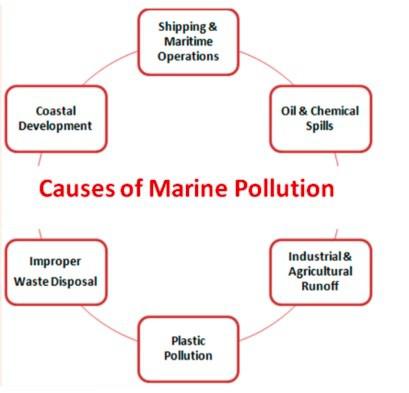Mains Daily Question
Oct. 18, 2023
Q.1 Discuss the problem of marine pollution, emphasizing its effects. Also, explain mitigation measures as prescribed under the London Convention of 1972. (10M, 150W)
|
Approach Introduction: Define marine pollution and state the objective of the London Convention 1972. Use a diagram to show the causes of marine pollution. Body: Heading 1: Effects of Marine Pollution: Heading 2: London Convention 1972 and Marine Pollution Mitigation: Conclusion: Suggestive steps in the way forward could be written as a conclusion |
.
Answer:
Marine pollution is the spreading of various harmful substances such as oil, plastic, industrial & agricultural waste, chemical particles, etc., in the ocean. The objective of the London Convention 1972 is to prevent marine pollution by controlling all the sources of pollution and preventing the dumping of wastes into the sea.
Effects of Marine Pollution:
- Harm to marine life through direct toxicity, physical entanglement, and disruption of marine habitats.
- For example, coral bleaching, Heavy metals/oil toxicity, fishing gear/plastic debris entanglement (Great Pacific Garbage Patch), etc.
- Damage to ecosystems by disrupting food chains and habitats.
- For example, oil spills kill algae disrupting the food chain, sewage discharge leading to algal blooms, etc.
- Depletion of oxygen in seawater: Excess debris in the ocean slowly degrades over many years, resulting in less oxygen in the ocean.
- For example, low levels of oxygen in the ocean lead to the death of ocean animals such as penguins, dolphins, whales, and sharks.
- Threat to human health: Pollutants in the ocean make their way back to humans. Small organisms ingest toxins and are eaten by larger predators, many of which are seafood that we eventually eat.
- For example, the toxins in contaminated animals when deposited in human tissue can lead to long-term health conditions, cancer, and birth defects.
- Economic impacts include damage to fishing and aquaculture industries, the loss of livelihood of coastal communities, damage to tourism, etc.
- For example, according to an Australian government study, Great Barrier Reef tourism areas are at risk of losing 1 million visitors per year and 10,000 tourism jobs.
London Convention 1972 and Marine Pollution Mitigation:
Measures to mitigate marine pollution under the London Convention 1972 are:
- Prohibition of dumping of certain substances including oil, radioactive waste, and heavy metals.
- Regulation of dumping of other substances by setting limits, making dumping zones, and other such strict criteria and guidelines.
- Coordination between parties to the convention through prior notification and consultation before engaging in dumping activities, allowing for an assessment of potential impacts.
- Monitoring is done by contracting parties and international organizations in terms of type and quantity of material dumped, along with location and method used for dumping.
- International cooperation and Research & Development are implicit features of marine pollution mitigation under the London Convention 1972.
Marine pollution poses a significant threat to marine ecosystems and human well-being. To mitigate its harmful effects, it is crucial to implement measures such as pollution prevention, proper waste management, stricter regulations, and public awareness to preserve the health and integrity of our oceans.


